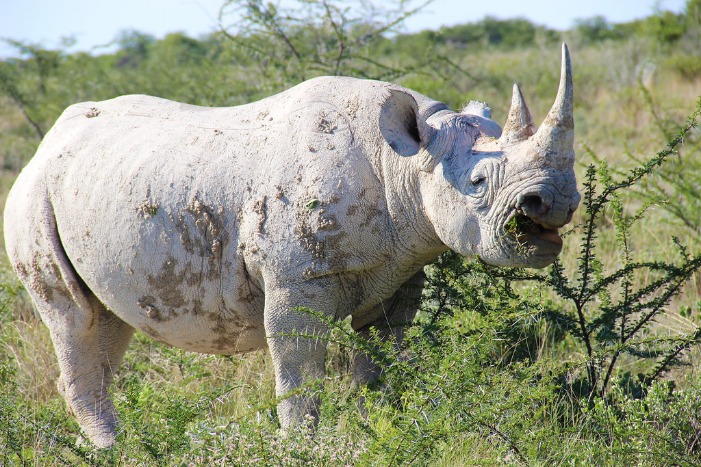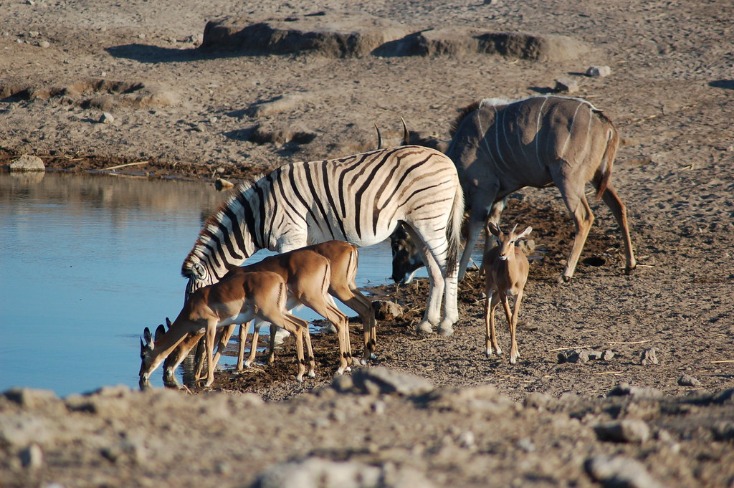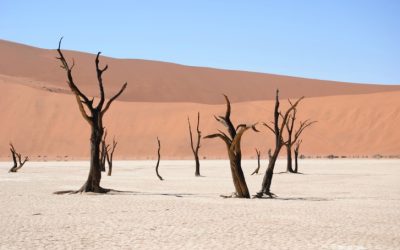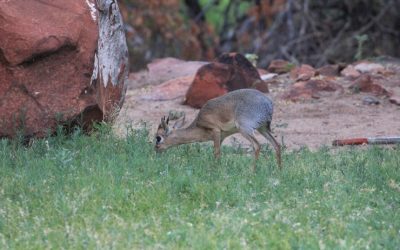Geographical Location and Landscape of Etosha National Park
Etosha National Park, located in northern Namibia, is renowned for its vast saltpan and diverse landscape. The park is situated in the heart of a semi-arid region, featuring expansive plains, acacia shrublands, and lush waterholes that attract a wide array of wildlife. Surrounded by remote desert scenery and characterized by its unique topography, Etosha offers a dramatic and picturesque environment that forms a vital habitat for numerous species. Its strategic location within the Namibian wilderness makes it a key destination for nature enthusiasts and wildlife explorers alike.
Position within Namibia
Etosha National Park is situated in northern Namibia, covering an expansive area of approximately 22,270 square kilometers. It is renowned for its unique landscape characterized by a vast salt pan that forms the center of the park, surrounded by open savannah, woodlands, and grasslands. The park’s geographical location places it within the Oshana Region, making it a prominent natural reserve in Namibia.
- Located in northern Namibia, near the border with Angola
- Centered around the large Etosha Pan, a salt desert that is visible from space
- Bordered by several waterholes that attract a wide variety of wildlife
- The park’s landscape is predominantly flat with some hills and acacia woodlands
Distinctive Landscape Features
Etosha National Park, located in northern Namibia, is characterized by a vast, flat semi-arid landscape that spans approximately 22,000 square kilometers. Situated within the Kalahari Basin, the park features expansive salt pans, notably the Etosha Pan, which is a distinctive and massive white clay desert that can stretch up to 470 kilometers in circumference. The region’s landscape is predominantly characterized by sparse savannahs, mopane woodlands, and open grasslands, providing a unique habitat for a diverse array of wildlife.
One of the most notable landscape features of Etosha is the Etosha Pan itself, a large, flat salt desert that remains dry for most of the year but temporarily fills with water during the rainy season, attracting thousands of flamingos and other migratory birds. Surrounding the pan are mineral-rich waterholes and springs, which serve as vital water sources for animals and create a mosaic of lush vegetation amid the arid environment. The park’s topography includes gently rolling plains and occasional low ridges, providing scenic vistas and vantage points for game viewing.
Major Waterholes and Salt Pan
Etosha National Park in Namibia is situated in the northern part of the country, spanning approximately 22,270 square kilometers. The park’s landscape is characterized by vast savannahs, open plains, and scattered woodlands, creating a diverse environment for wildlife. Central to the park’s geography is the massive Etosha Salt Pan, which covers about 4,800 square kilometers and lies in the heart of the reserve. Surrounding the salt pan are seasonal waterholes that attract a wide array of animals, making the area a focal point for wildlife viewing. These waterholes serve as essential watering points during dry seasons and are often the best places to observe wildlife congregations, particularly during periods of drought when water becomes scarce in other areas of the park.
Flora and Fauna of Etosha National Park
Etosha National Park in Namibia is renowned for its diverse and vibrant flora and fauna, making it a haven for nature enthusiasts and wildlife researchers alike. The park’s unique landscape, characterized by the expansive salt pan and surrounding woodlands, supports an abundant variety of plant and animal species. Visitors to Etosha can witness everything from majestic elephants and elusive leopards to a rich tapestry of birdlife and resilient plant communities, showcasing the area’s ecological significance.
Vegetation Types and Distribution
Etosha National Park in Namibia is renowned for its diverse flora and fauna, which thrive within a variety of vegetation types across the park. The landscape is predominantly characterized by expansive savannahs, acacia woodlands, and open grasslands, providing suitable habitats for a wide range of species. The park’s saline desert, the Etosha Pan, is a unique feature that temporarily attracts large concentrations of birds and other wildlife during the rainy season. Flora in the park includes species such as acacia trees, shrubs, and grasses that are adapted to the semi-arid conditions, supporting the diverse animal populations. The distribution of vegetation varies across the park, with denser woodlands near water sources, and more open grasslands and saline areas in the central parts, creating a mosaic of habitats that sustain the rich biodiversity of Etosha National Park.
Large Mammals and Predators
Etosha National Park in Namibia is renowned for its diverse flora and fauna, making it a prime destination for wildlife enthusiasts. The park’s landscape is characterized by vast salt pans, grasslands, and savannahs that support a wide variety of plant species, providing essential food and shelter for many animals. The rich vegetation sustains an abundant array of large mammals and predators, creating a vibrant ecosystem.
Among the large mammals found in Etosha, elephants are prominent, often seen bathing in waterholes or roaming across the plains. Black and white rhinoceroses are also present, although their populations are closely monitored due to poaching threats. Other notable large mammals include giraffes, lions, cheetahs, leopards, hyenas, and springbok, which thrive in the park’s diverse habitats.
Predators in Etosha include a variety of carnivores that play crucial roles in maintaining the balance of the ecosystem. Lions are the park’s apex predators, hunting large herbivores and often seen resting at waterholes. Leopards and cheetahs also prowling the grasslands, preying on smaller mammals and antelopes. Hyenas, known for their scavenging behavior, are common and often interact with other predators. The coexistence of these predators highlights the park’s vibrant and dynamic food web.
Bird Species and Migratory Birds
Etosha National Park in Namibia is renowned for its diverse flora and fauna, offering a rich habitat for a wide variety of species. The park’s landscape mainly consists of salt pans, grasslands, and open savannah, supporting an array of plant life that provides essential nourishment for the resident animals. The flora includes acacia trees, mopane, and various grasses that thrive in the semi-arid climate, creating an ecosystem that sustains a vibrant animal population.
The fauna of Etosha is equally impressive, featuring large populations of elephants, lions, cheetahs, black rhinoceroses, and buffaloes. The park is also home to numerous herbivores like giraffes, zebras, wildebeests, and springbucks, along with a host of smaller mammals and reptiles. The availability of waterholes throughout the park makes it an ideal location for observing wildlife, especially during the dry season.
Etosha is a critical birding destination, hosting over 340 bird species. Visitors can observe various species of raptors, waterbirds, and songbirds. The wetlands and pans attract large flocks of flamingos, pelicans, herons, and storks, especially during the rainy season when water levels are high. The park is also notable for endemic and migratory bird species, making it a significant site for bird enthusiasts.
Many migratory birds migrate to Etosha during the southern hemisphere summer, taking advantage of the seasonal water availability. Species such as the saddle-billed stork, African fish eagle, and the lesser and greater flamingos are commonly seen. These birds play a vital role in the park’s ecology by helping control insect populations and contributing to the overall health of the ecosystem. The diverse avifauna reflects the ecological richness of Etosha National Park, making it an extraordinary destination for nature lovers and birdwatchers alike.
Wildlife Conservation and Management
Wildlife conservation and management are essential practices to protect the rich biodiversity found in natural habitats around the world. In Etosha Park, Namibia, these efforts play a crucial role in preserving a diverse array of species and maintaining ecological balance. By implementing sustainable management strategies, the park ensures the survival of its unique wildlife while providing opportunities for eco-tourism and environmental education.
Protected Areas and Management Strategies
Etosha National Park in Namibia is one of Africa’s premier wildlife conservation areas, renowned for its vast salt pan and diverse ecosystems that support an incredible variety of flora and fauna. Effective management strategies are essential to preserve its rich biodiversity and ensure sustainable tourism. Protecting this unique environment involves a combination of habitat preservation, anti-poaching measures, and community involvement.
Conservation efforts at Etosha focus on maintaining the natural habitat and preventing illegal activities such as poaching and illegal resource extraction. Managed grazing, controlled tourism, and scientific research are also pivotal components of the park’s management plan. These strategies help balance human activities with the need to conserve wildlife, such as elephants, lions, rhinoceroses, and numerous bird species.
Management strategies implemented in Etosha include:
- Establishment and enforcement of protected area boundaries to prevent illegal incursions and poaching.
- Implementation of anti-poaching patrols equipped with modern technology such as surveillance cameras and aerial surveillance.
- Habitat restoration projects aimed at maintaining water sources and natural vegetation essential for wildlife survival.
- Community engagement programs that educate and involve local communities in conservation efforts to foster sustainable livelihoods.
- Tourism management practices that regulate visitor numbers, promote eco-friendly activities, and generate revenue for conservation projects.
Overall, the success of wildlife conservation and management at Etosha Park relies on adaptive strategies that integrate ecological, social, and economic considerations. Protecting this iconic park not only preserves Namibia’s natural heritage but also supports regional biodiversity and eco-tourism development.
Endangered and Rare Species

Etosha National Park in Namibia is one of Africa’s premier wildlife conservation areas, renowned for its diverse ecosystems and abundant animal species. The park plays a vital role in the conservation and management of endangered and rare species, ensuring their survival amid increasing environmental challenges.
Efforts to protect endangered species within Etosha include habitat preservation, anti-poaching measures, and scientific research. These initiatives are crucial for maintaining the biodiversity of the region and for the global effort to conserve threatened species.
- Black Rhinoceros: Once critically endangered due to poaching, Etosha is part of Namibia’s national efforts to protect the black rhinoceros through anti-poaching patrols and habitat management.
- West African Wild Dog: An elusive and highly social predator, the wild dog populations are monitored and protected within the park to prevent further decline.
- Desert-adapted Elephants: These elephants are specially adapted to Namibia’s arid environment, and Etosha serves as a key habitat for their conservation.
- Etosha Sable Antelope: As a species with limited distribution, the sable antelope benefits from protected areas like Etosha that offer safe breeding grounds and food sources.
Wildlife management in Etosha includes ongoing research, community involvement, and international collaboration to address threats such as poaching, habitat loss, and climate change. These efforts aim to ensure that Etosha remains a safe haven for its diverse and often endangered species for generations to come.
Research and Monitoring Programs)
Etosha National Park in Namibia stands as a vital region for wildlife conservation and management, playing a crucial role in preserving the diverse ecosystems and species found within southern Africa. The park’s extensive monitoring and research programs focus on understanding animal populations, their behaviors, and the environmental factors affecting their habitats. These initiatives help inform adaptive management strategies to ensure sustainable tourism, mitigate human-wildlife conflicts, and protect endangered species such as black rhinos and cheetahs. Continuous research efforts include aerial surveys, camera trapping, and ecological studies that contribute to a comprehensive understanding of the park’s biodiversity. Monitoring programs also track the impacts of climate change and invasive species, allowing park authorities to implement targeted conservation actions. By integrating community participation and scientific research, Etosha National Park exemplifies effective wildlife management aimed at maintaining ecological integrity for future generations.
Tourism and Visitor Experience
Etosha National Park in Namibia stands as one of Africa’s premier wildlife destinations, offering visitors a unique and memorable experience immersed in nature. The park’s vast salt pan, diverse wildlife, and scenic landscapes create an extraordinary setting for tourists seeking adventure and tranquility. Exploring Etosha provides opportunities for close encounters with wildlife, photography, and learning about conservation efforts, making it a must-visit destination for travelers craving authentic and immersive experiences in Africa.
Safari Activities and Game Drives
Etosha National Park in Namibia is renowned for its extraordinary wildlife and immersive visitor experiences. Tourists visiting the park can enjoy a variety of safari activities that allow for close encounters with Africa’s iconic animals within the stunning landscape of the savannah and salt pans.
Guided game drives are one of the most popular ways to explore Etosha. Visitors can join early morning, daytime, or evening drives to spot lions, elephants, rhinoceroses, giraffes, and numerous antelope species. The park offers a unique opportunity to witness animal behavior in their natural habitat, especially around waterholes that attract abundant wildlife.
In addition to game drives, self-drive safaris are available for those who prefer exploring at their own pace. Well-maintained roads and designated routes make it accessible for visitors with rental vehicles, giving them flexibility to stop and observe animals in more secluded areas.
Other safari activities include guided walking safaris and bird watching expeditions, which are ideal for nature enthusiasts keen to learn more about the park’s diverse flora and fauna. Accompanying knowledgeable guides enrich the experience with insights into animal tracking, behavior, and conservation efforts.
Etosha also offers luxury lodges and campsites near waterholes and main roads, providing comfortable accommodations that enhance the safari experience. These sites often feature viewing decks and picnicking areas so visitors can relax and enjoy the breathtaking scenery while keeping an eye out for wildlife.
Key Safari Activities in Etosha National Park
- Game drives at dawn, day, and dusk
- Self-drive safaris along designated routes
- Walking safaris with trained guides
- Bird watching excursions
- Wildlife photography safaris
Accommodation Options and Facilities
Etosha Park in Namibia is renowned for its incredible wildlife and unique landscape, offering visitors a memorable experience in one of Africa’s premier safari destinations. Tourists can enjoy game drives, guided safaris, and boat trips that allow close encounters with elephants, lions, giraffes, and other iconic species amid vast salt pans and lush waterholes.
Visitors to Etosha have a variety of accommodation options ranging from luxury lodges to budget campsites. These range facilities provide amenities such as swimming pools, guided tours, and comfortable lodging, ensuring a convenient stay for all travelers. Some lodges are situated within the park itself, offering spectacular views and early access to wildlife, while others are located outside the park for a more economical yet comfortable experience.
The park also features well-maintained facilities including visitor centers, picnic sites, and informative interpretive signs that enhance the experience. Guided tours and safaris are available to help visitors maximize their wildlife viewing opportunities and learn about the park’s ecological significance. Overall, Etosha Park provides an exceptional blend of natural beauty, diverse accommodation choices, and visitor amenities to ensure an unforgettable adventure.
Best Times to Visit and Seasonal Highlights
Etosha National Park in Namibia is a premier wildlife destination renowned for its expansive salt pan and diverse array of wildlife. Visitors can enjoy game drives, birdwatching, and the chance to see endangered species such as black rhinos and cheetahs in their natural habitat. The park offers a unique experience of Africa’s wilderness, attracting nature enthusiasts from around the world.
The best times to visit Etosha National Park are during the dry season from May to October. During these months, animals congregate around waterholes, making wildlife viewing easier and more rewarding. The cooler temperatures also contribute to a more comfortable safari experience. The period from July to September is especially popular for safaris due to the abundance of wildlife and the clear skies.
Seasonal highlights include the lush white salt pan after rare rains, which typically occur from the end of summer into early autumn, transforming the landscape and attracting migratory birds. The dry season offers outstanding game sightings, with animals concentrated near water sources, providing excellent opportunities for photography and wildlife observation. Additionally, spring months bring blooming wildflowers and a vibrant landscape, enhancing the scenic beauty of the park.
Cultural and Historical Significance
Etosha National Park in Namibia holds profound cultural and historical significance, serving as a symbol of the country’s rich heritage and natural beauty. This iconic wildlife sanctuary not only preserves diverse ecosystems and species but also reflects the cultural history of the indigenous peoples who have lived in the region for centuries. Exploring Etosha offers insights into Namibia’s past, showcasing the deep connections between its history, culture, and revered landscapes.
Local Communities and Indigenous Heritage
Etosha National Park in Namibia holds profound cultural and historical significance, deeply rooted in the indigenous communities and their rich heritage. The park is not only a vital sanctuary for wildlife but also a symbol of the cultural identity of local tribes such as the Himba, Herero, and Owambo, who have historically lived in harmony with the land and its resources.
The area surrounding Etosha has been inhabited for centuries, serving as a traditional hunting ground, gathering place, and spiritual site for various indigenous groups. Many sites within the park are considered sacred, and local communities continue to observe traditional customs and ceremonies that honor their ancestors and the natural world.
Moreover, Etosha’s history is intertwined with colonial pasts and conservation efforts, which have shaped the region’s heritage. The establishment of the national park has preserved its unique ecosystems and cultural landscapes, fostering respect for indigenous knowledge and practices.
- The Himba tribe, known for their striking red ochre body paint and traditional lifestyles, maintains cultural practices around water sources and wildlife within the park.
- Historical sites within Etosha, such as old wells and hunting grounds, reflect the longstanding relationship between local communities and the land.
- Efforts to preserve indigenous languages, crafts, and customs contribute to the ongoing cultural richness of the region.
- Community-based tourism initiatives aim to empower local residents and promote sustainable development that respects indigenous heritage.
Historical Landmarks and Discoveries
Etosha National Park in Namibia holds a profound cultural and historical significance, serving as a vital sanctuary for diverse wildlife and preserving the heritage of indigenous communities. The park’s landscape is shaped by its rich history of human interaction, with archaeological sites that reveal ancient human activity and settlement patterns. It is also a place where traditional customs and practices continue to thrive among local tribes, contributing to Namibia’s cultural tapestry.
Within Etosha, several notable landmarks and discoveries highlight its importance. The Etosha Pan itself is a unique natural feature, a vast salt desert that becomes a shimmering white expanse during the dry season. The park is home to numerous historical landmarks, such as waterholes that have served as crucial watering points for animals and humans over centuries. Archaeological excavations have uncovered artifacts dating back thousands of years, shedding light on early human presence in the region. Additionally, the numerous salt pans and mineral deposits have played a vital role in the area’s geological history, attracting early explorers and researchers interested in its natural history.
Ethical Tourism and Community Engagement
Etosha National Park in Namibia holds extraordinary cultural and historical significance, serving as a symbol of the country’s rich heritage and natural conservation efforts. The park is home to various indigenous peoples who have coexisted with the land for generations, and it preserves archaeological sites that reveal insights into ancient human activity. Ethically, tourism activities within Etosha emphasize sustainability and respect for both wildlife and local communities, promoting responsible travel that minimizes environmental impact and benefits local livelihoods. Community engagement is a cornerstone of Etosha’s approach, involving local communities in conservation efforts and tourism development, which fosters a sense of ownership and empowerment. This collaborative approach ensures that tourism contributes positively to the preservation of Namibia’s natural beauty and cultural identity while providing sustainable economic opportunities for residents.





0 Comments